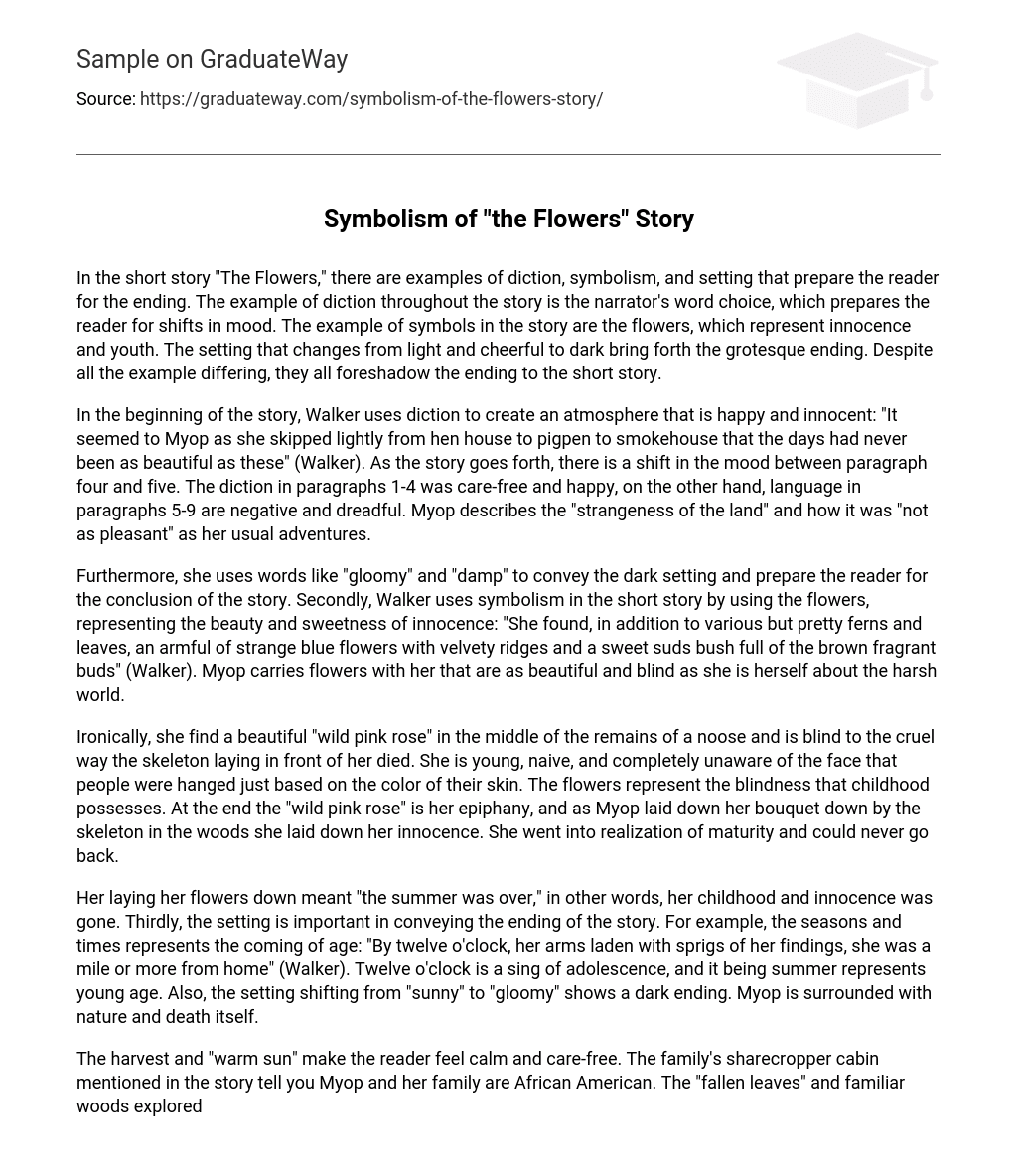In the short story “The Flowers,” there are examples of diction, symbolism, and setting that prepare the reader for the ending. The example of diction throughout the story is the narrator’s word choice, which prepares the reader for shifts in mood. The example of symbols in the story are the flowers, which represent innocence and youth. The setting that changes from light and cheerful to dark bring forth the grotesque ending. Despite all the example differing, they all foreshadow the ending to the short story.
In the beginning of the story, Walker uses diction to create an atmosphere that is happy and innocent: “It seemed to Myop as she skipped lightly from hen house to pigpen to smokehouse that the days had never been as beautiful as these” (Walker). As the story goes forth, there is a shift in the mood between paragraph four and five. The diction in paragraphs 1-4 was care-free and happy, on the other hand, language in paragraphs 5-9 are negative and dreadful. Myop describes the “strangeness of the land” and how it was “not as pleasant” as her usual adventures.
Furthermore, she uses words like “gloomy” and “damp” to convey the dark setting and prepare the reader for the conclusion of the story. Secondly, Walker uses symbolism in the short story by using the flowers, representing the beauty and sweetness of innocence: “She found, in addition to various but pretty ferns and leaves, an armful of strange blue flowers with velvety ridges and a sweet suds bush full of the brown fragrant buds” (Walker). Myop carries flowers with her that are as beautiful and blind as she is herself about the harsh world.
Ironically, she find a beautiful “wild pink rose” in the middle of the remains of a noose and is blind to the cruel way the skeleton laying in front of her died. She is young, naive, and completely unaware of the face that people were hanged just based on the color of their skin. The flowers represent the blindness that childhood possesses. At the end the “wild pink rose” is her epiphany, and as Myop laid down her bouquet down by the skeleton in the woods she laid down her innocence. She went into realization of maturity and could never go back.
Her laying her flowers down meant “the summer was over,” in other words, her childhood and innocence was gone. Thirdly, the setting is important in conveying the ending of the story. For example, the seasons and times represents the coming of age: “By twelve o’clock, her arms laden with sprigs of her findings, she was a mile or more from home” (Walker). Twelve o’clock is a sing of adolescence, and it being summer represents young age. Also, the setting shifting from “sunny” to “gloomy” shows a dark ending. Myop is surrounded with nature and death itself.
The harvest and “warm sun” make the reader feel calm and care-free. The family’s sharecropper cabin mentioned in the story tell you Myop and her family are African American. The “fallen leaves” and familiar woods explored before put the reader at ease, but when the setting shifts to “strange and “silent” the reader automatically feels negative. The body she found changes the setting to sympathetic knowing his head was laying beside him the remains of a noose near by. The bones and green buckles on the over alls show how long he has been there under ” an over hanging limb of a great spreading oak. The setting gives the details needed to feel as if the reader was there with Myop on her adventure to adult hood. In Walker’s “The Flowers” examples of diction, symbolism, and setting prepare the reader for the ending. The transition in diction, symbolism, and setting all propel Walker’s theme, the coming of age, and help draw conclusions to the ending of this short story. The last sentence clearly indicates a complete end of summer, but the meaning is the complete end of innocence for Myop.





